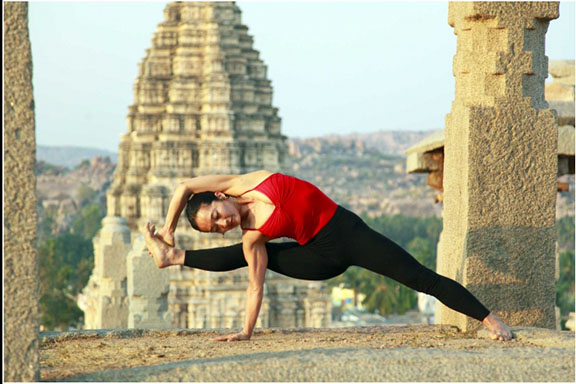 Questions about the origins of Yoga and whether Yoga is a part of the Hindu religion have arisen over the years in Yoga classes, teacher training programs and universities. In this interview, Dr. Graham Schweig, a scholar and a yogi, tackles these perennial questions. He goes to the very heart of the Rig Veda to reveal Yoga’s central teaching, an innermost and secret teaching that is more fully explored in Yoga’s greatest texts.
Questions about the origins of Yoga and whether Yoga is a part of the Hindu religion have arisen over the years in Yoga classes, teacher training programs and universities. In this interview, Dr. Graham Schweig, a scholar and a yogi, tackles these perennial questions. He goes to the very heart of the Rig Veda to reveal Yoga’s central teaching, an innermost and secret teaching that is more fully explored in Yoga’s greatest texts.
Integral Yoga Magazine: How old is Yoga?
Graham Schweig: Yoga goes back in time further than the historical eye can see. The existence of Yoga is acknowledged here and there in the Vedas, but Yoga practice existed concurrently with Vedic religion. Four major periods of Yoga can be observed: Ancient Yoga, pre-Classical, Classical and post-Classical. Ancient Yoga has been dated up to about 800 BCE. There is a description in the Rig Veda of a long-haired ascetic who has attained paranormal capacities. In the Artharva Veda, there are descriptions of practicing yogis who engage in austerities, breathing exercises and bodily postures. And evidence of shamanistic techniques of trance, ecstatic and enstatic (superconscious) states, are found in steatite seals and terra cotta figurines of the Indus Valley civilization, which existed between 2500 and 1500 BCE.
There were yogis practicing on the periphery of society who were reclusive in their practices, and then within society you had the Brahmins, the priestly class preserving and enacting the Vedic traditions. Vedic hymns speak of agni hotra (fire rituals) and sacrifices, philosophical speculation, and supplication or offerings of the heart to the divine, the forerunners of Karma, Jnana and Bhakti Yogas, respectively. These three—sacrifice, speculation and supplication—represent the outer, inner and innermost layers of Yoga. Vedic religion thus contributes to a powerful foundation for Yoga.
Pre-classical Yoga occurred from 800 BCE to 200 CE, a period that is well known for the sacred texts of the Upanishads. People had become disillusioned by the opportunism and avarice of the Brahmins—indeed, they began sacrificing animals—who became exploitative and took advantage of their position. Siddhartha Gautama (the Buddha) and the sage Mahavira of Jainism, appeared in the earlier part of this period. The Jains and Buddhists rejected the Vedas and emphasized a doctrine of ahimsa (nonviolence). At the same time, there were sages of the forest who taught, as recorded in the Upanishads, that indeed sacrifice was important, but it was an inner sacrifice. We see this idea reflected in the teachings of the Bhagavad Gita: The in-going breath is sacrificed to the outgoing breath and vice-versa, leading to a state of suspended breathlessness. These sages described the parts of sacrifice as being part of the one true being (Brahman). The inner fire of tapas was spoken about. The spirit of the Upanishads was reclusive and meditative, while the mood was philosophically deep and reflective.
It is in this pre-Classical period that the word ìYogaî first appears, a period during which the major classical sacred texts of Yoga emerge: the key Upanishads on Yoga; the Bhagavad Gita within the Mahabharata; and the Yoga Sutras of Patanjali. Yoga is mentioned in the later Upanishads, the Katha, Svetashvatara and Maitri. The words “asana” and “pranayama” are also found in these texts. It was at the end of this period that Patanjali systematized these various traditions and practices of Yoga into the famed Yoga Sutras. The Yoga Sutras represent the culmination of the many centuries of Yoga practice. You can see that the Yoga Sutras is a cumulative text; there are many different teachings of Yoga that are synthesized—that is what a sutra essentially does. And we find in the Bhagavad Gita that the practice and perfection of Yoga can be achieved and practiced not just in seclusion but also in any position or situation within human society. By the end of this period, Yoga has come into its own self-identity, its systematic practice and its relationship to and vision of the self and ultimate reality.
IYM: When do the first commentaries on the Sutras appear?
GS: In the Classical period of Yoga, which went from about 300 to 900 CE, we find the Bhashya of Vyasa which was the first major commentary. It is in this period that we find the Hatha Yoga Pradipika, the most important text on Hatha Yoga, and which also explores Nada and Kundalini Yogas. The post-Classical period is from 900 CE to the present day. Tantra Yoga began in the Classical period and became much more engaged in the post-Classical period. We find medieval texts comprised of tantric ritual, auditory and visual techniques, along with interest in paranormal states and there were catalogs of unusual body postures. At the start of this period, Islamic rule was taking over the north of India. The Muslims would destroy Hindu temples and build mosques over them, but Tantra and Yoga were something they couldn’t touch. Seekers couldn’t build temples so, instead, they built up the bodily temple. During times of external strife and struggle, it’s common for the more reclusive practices to kick in. Studies of human physiology and the psycho-physical effects of Yoga thrived during this period and continues on to this day, especially in the West.
IYM: Is Yoga part of Hinduism?
GS: Yoga arose out of spiritual India—that is indisputable. The very character of Indian civilization, from its very beginnings, is the ìsearch for holiness,î as the great historian William McNeill has written. There is no doubt that Yoga arose from the spiritual depths of India. There was no label or, what we retroactively call Hinduism, back at the time when Yoga developed. The label ìHinduî was a name Persian invaders, in the 9th century, affixed to those dwelling on the east side of Indus River, practicing Sanatana Dharma (eternal truth). Since that Persian invasion, those who accepted the Vedas as foundational texts of their belief and faith, were called Hindus. Buddha and Mahavir rejected the Vedas, so they were not Hindu traditions. All other traditions coming after the Vedas, who accepted the Vedas even if they did not necessarily embrace them, were Hindu sects. Yoga does not reject the Vedas and, as we have just discussed briefly, develops and perfects Vedic practices, so it would therefore be technically considered Hindu in terms of a label. If you were talking to an academic historian, Yoga would be designated as Hindu because it has a relationship with the Vedas and additionally because it needs to fall under a convenient, religio-cultural designation and category. That’s what we do in academics—we observe and identify designations and categories, but the larger question is a question of personal identification.
IYM: What do you mean by “personal identification?”
GS: Whether we call Yoga Hindu or not Hindu we are arguing for a temporary designation. We are missing the very essence of the Vedic dictum: “ekam sat vipra bahudha vadanti” (Rig Veda 1.164.46). Interestingly, this famous statement is usually translated as: “truth is one, sages call it by many names.” More accurately, it should be translated as follows: There is one true being (sat). Deeply inspired ones (vipra—which means “shaking,” almost like shamans do in a trance state), in various ways (bahudha) speak about it (vadanti). According to this passage of the Rig Veda, there is one true being (the word satya in Sanskrit, as distinguished from sat). Truth, or satya, is the state or quality of being true, or sat; it is a something that is believed to be or accepted as true. But the Vedas here use the powerful ontological language of sat, thus presenting “reality” or “beingness.” And, this is the key point on which to focus rather than any kind of religious label, designation or dogma. When we speak about one true being, when we speak of the one reality, we are talking about going deep within ourselves, our traditions, in order to connect and develop a relationship with the very heart of true being, or ultimate reality.
The deeply inspired ones were speaking about a powerful and profound sense and grasp of the eternal. Our identity as yogis is to be with that state of true being rather than with a temporary identity of any kind. The problem with religion is it too often undoes itself, it unravels itself, due to a false sense of identification. It becomes yet another extremely powerful yet temporary identity that separates each of us from one another, which is exactly what real religion—eternal truth—wants to get us away from. The only one and true religion is the religion of the heart. All else is embellishment—good or destructive embellishment. Why has so much blood spilled in the name of religion? That is because it can be the most destructive type of identification. The real purpose of religion and of Yoga is to be identified with our eternal selves in relation to the eternal Self.
IYM: We’ve certainly seen the dangers of putting labels.
GS: Yes, and by putting the labels we get distracted from the state of being fixed on the “single highest point,” or ekagrata. If we are Hindus, Jews, Christians or Muslims we need, like yogis, to go deep within the inner Self and draw out from that resource and then share with others. The idea here is to share with others what we have drawn first from our deep spiritual probing, not because others happen to be part of our own tradition, but because they are true spiritual beings—brothers and sisters within true being. Going deep is Yoga and you can find Yoga at the heart of each religion. “From deep within the heart, pure consciousness is fully known” (Yoga Sutras, 3.35). It comes out of spiritual India and some say that’s Hindu, but that’s semantics. The point is to make sure one’s Yoga is grounded in ekam sat—the one reality. As long as we identify ourselves as true beings within the one true being, does it matter what we label ourselves?
 Dr. Graham M. Schweig received his doctorate from Harvard University and is a scholar of Comparative Religion. His field is the philosophy of Yoga and the spiritual traditions of India. He is the author of the Dance of Divine Love and Bhagavad Gita: The Beloved Lord’s Secret Love Song. For more information, please visit: www.grahamschweig.com and www.secretyoga.com.
Dr. Graham M. Schweig received his doctorate from Harvard University and is a scholar of Comparative Religion. His field is the philosophy of Yoga and the spiritual traditions of India. He is the author of the Dance of Divine Love and Bhagavad Gita: The Beloved Lord’s Secret Love Song. For more information, please visit: www.grahamschweig.com and www.secretyoga.com.

